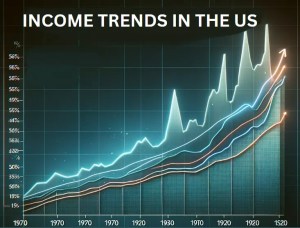Deciphering the Middle Class US Salaries of Today
As we venture into 2024, the discourse around middle class US salaries remains a vital and ever-evolving subject. This article aims to provide an in-depth analysis of what it means to be middle class in contemporary America. We’ll explore the historical evolution of middle class incomes, scrutinize the current figures and trends, and investigate the regional disparities that shape the middle class experience. By dissecting these aspects, we aim to offer a clearer understanding of the middle class economic landscape, vital for both individuals navigating these waters and policymakers shaping the future.

Evolving Landscape of Middle Class Salaries in the US: A Historical Perspective
The concept of a middle class salary in the US has undergone significant changes over the decades. Understanding this historical evolution is key to comprehending the current state and challenges of the middle class. This section delves into the shifting trends and dynamics that have shaped middle class incomes from the past to the present day.
Middle Class Income Trends: The Past Fifty Years
In the last half-century, the American middle class, once the majority, has seen a gradual decline. From 1971 to 2021, the proportion of adults in middle class households decreased from 61% to 50%. This contraction reflects broader economic shifts and changes in income distribution across various classes.
The Shrinking Middle Class
The decline in the middle class has been paralleled by growth in both the upper and lower-income tiers. The share of adults in the upper-income bracket rose from 14% to 21% between 1971 and 2021, while the lower-income tier expanded from 25% to 29%. These changes highlight the increasing polarization of income distribution in America.

Income Growth: Middle vs. Upper Class
Although household incomes have generally risen, the growth has been uneven across different income tiers. Middle class households saw their median income increase by 50% from 1970 to 2020. In contrast, upper-income households experienced a more significant rise of 69% during the same period. This disparity underscores the widening economic gap between the middle and upper classes.
The Redistribution of Aggregate Income
The proportion of aggregate U.S. household income held by the middle class has consistently decreased since 1970. While middle-income households accounted for 62% of aggregate income in 1970, this figure dropped to 42% by 2020. Conversely, the share of aggregate income for upper-income households increased from 29% to 50% over the same period. This shift reflects the growing concentration of wealth among the higher-income segments of the population.
The historical trends in middle class US salaries reveal a complex narrative of economic shifts and income redistribution. The gradual decline of the middle class and the growing disparity in income growth between different classes are crucial factors shaping the current economic landscape. Understanding these trends provides valuable context for analyzing the present challenges and future prospects of the middle class.

Regional Variability in Middle Class Salaries in the US: 2024 Update
The definition and scope of middle class US salaries are not uniform across the country. This section provides a comprehensive look at the regional differences in middle class incomes, highlighting how geography, industry, and demographic factors create a diverse tapestry of middle class experiences across various metropolitan areas.
Defining Middle Class Across Regions
The concept of a middle class income varies significantly from one metropolitan area to another. While some analyses use a uniform national definition, others adjust based on local median incomes and living costs. This variability reflects the diverse economic realities of different regions, making the term ‘middle class’ flexible and context-dependent.

Varied Middle Class Sizes in Metropolitan Areas
The size of the middle class varies considerably across the nation’s 382 metropolitan areas. For instance, places like Bloomington, Illinois, and Jacksonville, North Carolina, have notably different proportions of middle class households. Smaller and mid-sized metro areas tend to have larger middle class populations, often influenced by local industries like manufacturing, military, or specific community structures.
Geographical Diversity in Middle Class Composition
The composition of the middle class differs across various regions. Metro areas with smaller middle classes often include college towns with significant student populations and tech hubs with high-income jobs, like the San Francisco Bay Area and Boston. Moreover, the racial makeup and prominent industries in a metro area significantly impact the size of its middle class. Areas with larger non-Hispanic white populations or those dominated by industries like retail and manufacturing tend to have larger middle class populations.
Economic Health and Middle Class Dynamics
The economic health of a region, as reflected in the growth or decline of the middle class, is intricately linked to broader demographic and industrial patterns. Regions with expanding middle classes often reflect upward mobility, whereas those with shrinking middle classes might indicate economic challenges or shifts towards higher-income brackets.
The Case of Median Household Income
Changes in median household income provide further insight into regional economic health. For instance, in the Appleton, Wisconsin metro area, a decline in middle class household share coincided with a drop in median household income, possibly due to shifts in the job market from higher to lower-middle-class wages.
The regional variability in middle class salaries in the US highlights the complex interplay between demographics, industry, and economic health. Understanding these regional differences is crucial for grasping the broader narrative of the middle class in America. This nuanced view allows for a more targeted approach to addressing the needs and challenges of the middle class across different metropolitan landscapes.

Recent Economic Trends and Their Impact on Middle Class Income in the US: 2024 Outlook
The economic landscape of 2024 is shaping up with several key trends impacting middle class income in the United States. This section examines the current economic indicators, their implications for the middle class, and the broader context of wage growth and income distribution.
Economic Indicators and Middle Class Prospects
The US economy in 2024 shows positive signs with increased consumer spending, real wage gains, and a rise in consumer confidence. However, these optimistic trends contrast with a weaker consumer sentiment, partly influenced by memories of recent high inflation rates. While inflation has eased from an average of 6.4% to 3.1%, the cumulative price increase over the past three years continues to affect consumer outlook.
Labor Market Disruptions
The COVID-19 pandemic’s long-term effects on labor markets have led to reduced labor force participation and increased difficulty among working-age adults in cognitive functions, disproportionately affecting women and non-college graduates. These factors could potentially influence the earning capabilities and stability of middle class households.

Middle Class Income Growth: A Lagging Trend
Middle class income growth has been consistently outpaced by both the top and bottom income tiers over the last four decades. The top 20% of earners have seen their income double, while the bottom 20% has experienced a growth of 84%, significantly higher than that of the middle class. When healthcare costs are excluded, the growth for the middle class is even more modest, dropping from 47% to 32%.
Wage Growth Disparities
The typical American worker, representative of the middle class, has seen minimal wage growth compared to the economy’s overall growth and the upper income brackets. The wage gap has widened, with the 90th percentile earning significantly more per hour than the middle and lower percentiles. Factors like globalization, declining union membership, and economic dynamism have contributed to this disparity.
The Future Outlook for Middle Class Incomes
Looking forward, the prospects for significant income growth in the middle class are not promising. Since 1979, income growth has been slowest for the middle class, growing at half the rate of the top and bottom income percentiles. There is no immediate indication that this trend will reverse, or that middle class incomes will catch up to the faster-growing segments.
The economic trends of 2024 present a mixed picture for the middle class in the US. While overall economic indicators are positive, the lingering effects of the pandemic on the labor market and the longstanding issue of sluggish middle class income and wage growth paint a challenging picture. Understanding these trends is essential for policymakers and stakeholders to address the unique challenges faced by the middle class effectively.

The Changing Distribution of Income and Its Impact on the Middle Class in 2024
The distribution of income in the United States has undergone significant changes, profoundly affecting the middle class. This shift in income distribution, compounded by evolving economic challenges, has led to notable disparities within the middle class, particularly impacting those nearing retirement.
Decline in Middle Class Share of Aggregate Income
Since 1970, the middle class’s share of aggregate U.S. household income has steadily decreased. Middle-income households, which held 62% of aggregate income in 1970, saw this figure drop to 42% by 2020. This decline underscores a gradual yet significant shift in economic power away from the middle class.
Rising Share of Upper-Income Households
In contrast, the share of aggregate income held by upper-income households has increased, rising from 29% in 1970 to 50% in 2020. This trend indicates a growing concentration of wealth among the upper-income tier, further highlighting the economic divergence within American society.
Lower-Income Household Income Share
The share of aggregate income for lower-income households experienced a marginal decrease from 10% to 8% during the same period. This change occurred despite an increase in the proportion of adults living in lower-income households, reflecting broader economic shifts.

Decline in Middle Class Resources and Growing Disparity
Recent studies, including one highlighted in a New York Times article, reveal that the lower middle class has steadily lost financial ground over the past two decades. This segment of the population, particularly those nearing retirement, has not seen its economic resources keep pace with early 1990s levels, raising concerns about their future financial security.
Splitting of the Middle Class
The middle class has effectively divided into two segments: the more financially secure upper tier and the increasingly precarious lower middle class. In 2018, the upper middle class had average annual resources exceeding $90,000 per person, whereas the lower middle class had less than $32,000, signifying a marked bifurcation in economic well-being.
Health and Life Expectancy Disparities
The economic challenges faced by the lower middle class have extended beyond financial security, affecting health and life expectancy. This group experiences more chronic health conditions, higher smoking rates, and a slower decline in serious health problems compared to their upper middle class counterparts.
Urgent Policy Considerations
The growing disparity within the middle class presents critical policy challenges. Measures like bridge benefits for physically demanding jobs, increased Social Security solvency, and programs focusing on rehabilitation, workplace accommodations, and retraining are vital for enhancing the financial stability and health of the lower middle class.
The income distribution landscape in the US as of 2024 highlights an urgent need for targeted policies to address the widening gap within the middle class. The challenges faced by the lower middle class, in terms of retirement security and health, emphasize the importance of addressing these disparities to ensure dignity and stability for all segments of society in their later years.

Conclusion: Navigating the Middle Class Income Landscape in 2024
As we conclude our exploration of middle class incomes in the US in 2024, several key themes emerge, painting a complex picture of the economic and social realities faced by this segment of the population.
- Evolving Definition and Income Levels: The definition of what constitutes a middle class income in the US is not static and varies significantly across regions. The economic landscape of 2024 shows that the middle class now spans a wide range of income levels, influenced by factors such as geography, industry, and demographics.
- Historical Income Trends: Over the past five decades, there has been a notable contraction in the middle class, with a declining share of aggregate income and a growing income gap between the upper and middle classes.
- Regional Variabilities: Middle class incomes in the US are highly region-specific. Metropolitan areas exhibit varying sizes of middle class populations, influenced by local economic conditions, industry presence, and demographic makeup.
- Recent Economic Trends: The economic indicators of 2024, including consumer spending and real wage gains, present a mixed impact on the middle class. While overall economic conditions appear optimistic, the realities of wage growth and income distribution tell a more nuanced story, particularly for the lower middle class.
- Income Distribution and Class Division: The most striking development is the increasing bifurcation within the middle class itself, dividing into more secure upper tiers and a vulnerable lower segment. This split is not only financial but extends to aspects of health and life expectancy, underscoring the widening disparities within what was once a more homogenous economic group.
- Policy Implications: The current income distribution trends call for urgent policy interventions. From enhancing Social Security benefits to providing targeted support for physically demanding jobs, a range of measures are needed to address the challenges facing the lower middle class.
In summary, the middle class in the US in 2024 faces diverse and significant challenges. Understanding these complex dynamics is crucial for stakeholders, policymakers, and individuals alike, as they navigate the realities of middle class life in an ever-changing economic landscape.
Resources Used in Article Creation
To compile this comprehensive overview of middle class incomes in the US as of 2024, the following resources were instrumental:
- Pew Research Center (www.pewresearch.org): Offered detailed data and analysis on middle class income trends, historical changes, and income distribution in the United States. This source was pivotal in understanding the evolving dynamics of the middle class over the past decades.
- The New York Times (www.nytimes.com): Provided insights and personal stories reflecting the current economic conditions and challenges faced by the middle class. Their articles, especially those focusing on retirement and health disparities, gave a human perspective to the statistical data.
- Brookings Institution (www.brookings.edu): Served as a valuable source of in-depth research and analysis on various aspects of middle class income distribution, economic health, and policy implications. Their reports offered a nuanced view of the economic landscape facing the middle class.
- Reuters (www.reuters.com): Contributed crucial information on the overall economic outlook for 2024, including consumer spending trends, wage gains, and consumer confidence. This helped in understanding the broader economic environment influencing middle class incomes.
- Stanford Institute for Economic Policy Research (SIEPR) (siepr.stanford.edu): Provided insights into recent economic trends, including labor market disruptions and the pandemic’s long-term effects on the economy. Their research added depth to the discussion on how recent global events are shaping the economic prospects of the middle class.
Additionally, government data and statistics, including reports from the Bureau of Economic Analysis and the U.S. Census Bureau, provided accurate and up-to-date information on income and economic trends. Academic research and studies also contributed to the depth and context of the discussion on middle class income dynamics and policy implications.
These diverse sources combined to offer a well-rounded and detailed perspective on the state of middle class incomes in the United States as of 2024, ensuring a comprehensive exploration of the topic.

Join the Conversation at Simply Sound Society
We invite our readers to become an active part of our community by joining the Simply Sound Society. This forum is a vibrant space where your voice can be heard, and your insights can make a difference. Share your experiences, perspectives, and thoughts on the evolving landscape of middle class US incomes. Whether you have personal stories, professional expertise, or just a keen interest in the topic, your contribution is valuable.
Engage with others who are navigating similar challenges, offer support, or gain new understanding through diverse viewpoints. The conversation extends beyond just reading; it’s about participating, sharing, and learning together.
Don’t forget to also share your thoughts in the comments section below. Every comment enriches the discussion, providing a broader range of perspectives and deepening our collective understanding of this crucial topic. Whether you agree, disagree, or have questions, your engagement is what makes Simply Sound Society a dynamic and inclusive community.
Join Simply Sound Society today and be a part of a meaningful dialogue about middle class incomes in 2024 and beyond. Let’s explore these issues together and work towards solutions that benefit everyone.
- Mastering the Mortgage Process: The #1 Guide to Home Buying
- Exploring Healthy Fast-Food in 2024: The Surprising Truth
- The Sesame Care Advantage: Revolutionizing Healthcare Access
- Healthcare Assistance for Low-Income Families in the U.S.
- Ultimate Guide to Assistance Programs in the U.S.: Federal, National, and State-Specific Support
















hello fellow Bloggers
Thanks – PomKing
http://www.pomeranianpuppies.uk